
Dear Reader,
I was recently asked to translate my review of the Ethos 13mm and the Explore Scientific 14mm. I found that a machine translation delivered inacceptable results. Instead I translated the text myself but as I am not a native English speaker I found it impossible to translate the text word by word. I decided to re-write the article in English. I did my best to use the correct technical terms and I am sure that I made a number of mistakes. But I think that the article is understandable and easier to read than a machine translation.
14mm Explore Scientific 100°
and
Televue Ethos 13mm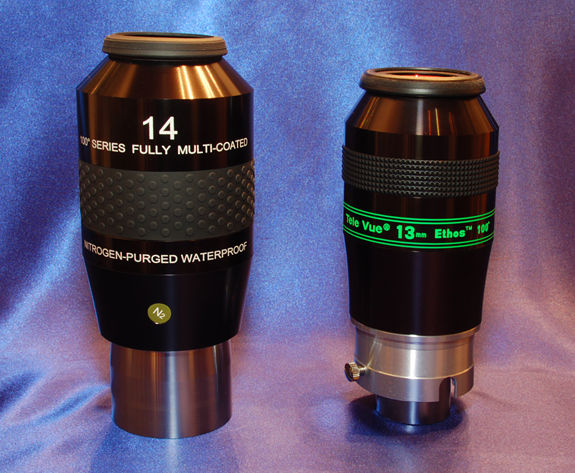
One hundred degrees apparent field of view is what I noticed first about the new 14mm Explore Scientific eyepiece. Only a few eyepieces offer such a large field. On the european (mainstream-) market of fall 2009 only Televue’s Ethos series featured one hundred degrees. Namely their 13mm Ethos is a direct competitor to the 14mm. Or is Televue’s first Ethos more than just a competitor? In fall 2009 I had the chance to compare them in detail.
Explore Scientific’s website offers an extensive amount of information about their 14mm. According to their site eye relief is 14.5 millimetres. A schematic view shows a 9 lens design with 5 groups. Lanthanum glas and at least 3 other glasses were used. The effective field stop diametre is 24.43mm. Of course the eyepiece offers an FMC grade coating, blackened edges and an internal baffle system. An unusual feature for an astronomical eyepiece is the waterproof built. According to the manufacturer each eyepiece is filled with nitrogen gas and spends some thirty minutes one metre underwater.
The eyepieces 2” barrel looks like a marginal detail among these features. The effective field-stop diametre seems to allow a 1.25”-design but as the lens setup contains a negative element in front of the internal focal plane the first lens needs a larger diametre than an 1.25” barrel can offer.
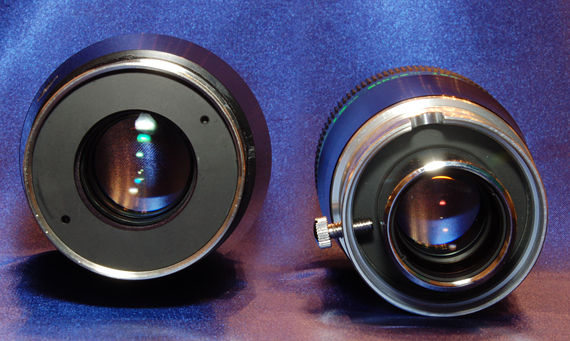
Looking at the barrels: Ethos 13mm (right) and Explore Scientific 14mm (left).
The 13mm Ethos however comes with combined 2” and 1.25” barrels. It’s negative element uses as much diametre as possible inside of the 28.5mm filter thread. The carefully blackened lens retainer is screwed into the filter thread and offers some 26 millimetres free diametre for the negative element. Of course Televue offers a lot of information as well. 22.3 millimetres for the effective field stop diametre, 15 millimetres of eye relief and ‘ultra low reflectance, high efficiency coatings tuned to the composition of each element’. What they don’t tell us however is the lens setup. In the past Televue’s eyepiece-comparison table gave us the lens setup for every Televue eyepiece on the market. For their Ethos series they left that field empty and maybe to keep some nosy eyes out of the internals of their newest eyepiece designs they left a small note in the package: ‘Warning: Do not unscrew any sections of the eyepiece, as the lenses may fall out, thereby voiding the warranty.’
Yes! The Panoptic problem. From time to time there’s someone sweeping up the shards of glas that rained from his Panoptic after it was opened for whatever reason. They send the remains to Televue, get the broken lenses replaced and everything refittet before they send it back along with a nice bill. We’ll see, however, if Televue could protect their secrets that way. I restrained myself to try if they (at least) cemented the dangerous threadings to avoid costly accidents.
Another detail about the 13mm Ethos is that its overall diametre was reduced to allow for binocular use after pilot testers suggested this. Finally the Ethos can be fitted with Televue’s dioptrix astigmatism corrector that should allow everyone to use this eyepiece without wearing glasses.
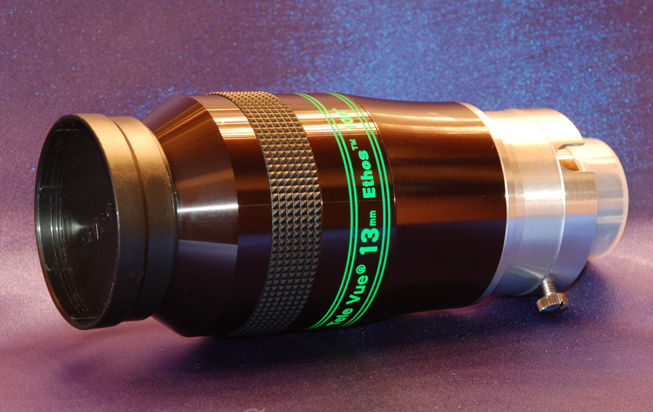
Televue’s 13mm Ethos takes up more space than neccessary when it is stored with the original cap.
Comparing both eyepieces I had the usual look at their physical dimensions. The Explore Scientific weighs an astonishing 877g (31 oz). So the Ethos appears lightweight with 571g (20 oz) but of course that’s still quite a load for most focusers. The Explore Scientific is about 155 millimetres (6.1”) long and 70 millimetres (2.75”) in diametre. With the lens caps on the Ethos reaches 150 millimetres length. The eyepiece could’ve been some 7 millimetres shorter if Televue hadn’t used the standard lensecap from their type 5 Naglers for the eyelens. These lense caps have a two diametre design and fit on the folded rubber eyeguard with one side and on a 2” barrel with the other side. However the combined 2” and 1.25” barrel design of the Ethos doesn’t allow a 2” cap on the bottom side of the eyepiece. The Ethos has a maximum diametre of 63.5 millimetres (2.5”). Important for binocular use.
Looking at the 2” barrels is actually quite interesting. Explore Scientific offers what they call a double taper barrel instead of the usual undercut to prevent the eyepiece to drop out of the socket. Compression rings however tend to jam inside of the standard undercut which turns a safety feature into a safety hazard. The conical form of the 2” barrel prevents this and is still an effective and necessary detail concerning the price and the weight of the eyepiece. Of course Explore Scientific isn’t the first to introduce this feature. It is well known from other eyepieces like William Optic’s 28mm UWAN. So one might think that Al Nagler should’ve somehow realized that something like this exists and has proven it’s effectiveness. However even with the combined 2” and 1.25” barrel that allows extensive material thickness for the 2” barrel Televue kept the old (un-)safety undercut. The 1.25” barrel inside of the Ethos’ 2” barrel comes completely wihout any effective measures to secure an eyepiece of that weight. Instead they came up (again…) with that decades old screw through the 2” barrel. With it you could clamp the eypiece against the outside of a 1.25” socket… well… if there’s something to clamp on. Take a modern 2” diagonal and it’s flat built 1.25” reducer and there goes nothing! Even the notch for the 1.25” lock screw will be useless as the reducers 2” diameter will prevent the 2” barrel of the eyepiece to slide over it. Considering that most people who use a 100° eyepiece will also have a 2” option on their telescopes the old fashioned barrel design of the 13mm Ethos is potencially dangerous. Furthermore the 1.25” barrel sticks out some (very necessary) millimetres from the lower edge of the 2” barrel. It needs a total of 42 millimetres from the top edge of a 2” socket and might collide with the mirror or prism surface of your diagonal or you might scratch a flattener or coma corrector. While Televue noticed this and applied a warning about it they didn’t spend much time to think about a practical solution. It would have been so easy: They should’ve delivered the eyepiece with a normal 1.25” barrel and a thread to fit a 2” barrel of the same length. What they did however is that they chose to offer a 2” barrel extension to fit 2” filters. Looks like they just don’t see it. Wow!
By the way- you might notice on the pictures that the 2” barrel on the Ethos is made of aluminium. Of course this saves weight but as it is not anodized it is not resistent to scratching and there are indeed some occasions when you would turn the eypiece. For example to adjust the length of a coma corrector like the Paracor. If the eyepiece is not tightly secured it may slip and is likely to receive scratches.
Looking at the 2” barrel on the 14mm Explore Scientific however reveals a single word: ‘CHINA’ while the Ethos wears a ‘TAIWAN ROC’ on its black anodized tube.
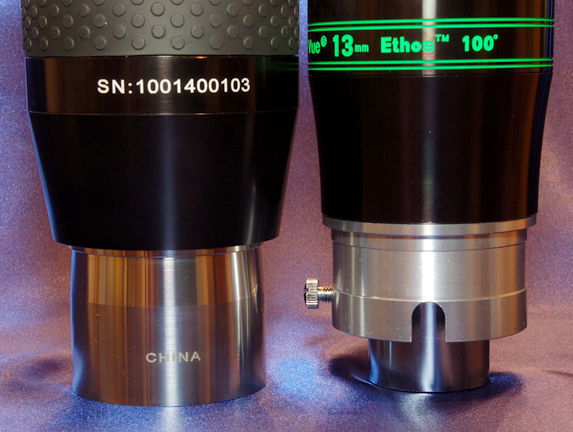
The Explore Scientific (left) has a conical shaped 2” barrel while Televue’s old fashioned safety undercut
is well known for causing problems with compression rings.
Regardless of their origin workmanship is great for both eyepieces. I can only talk about small details. The Explore Scientific’s cap for the 2” barrel has a loose fit. The 1.25” filter thread of the Ethos is not blackened but very close to the (blackened) lens retainer and the lens itself. The coatings appear to be good on both eyepieces. The Explore Scientific has a larger rubber grip and handles slightly better than the Ethos with its relatively small rubber grip. Their packaging is very similar. Sturdy cardboard boxes with foam plastic mouldings. Positive detail for the Ethos: It comes with a page of instructions. Negative detail for the Explore Scientific: The eyepiece is not that much larger than the Ethos so it wasn’t at all necessary to put it into a box with almost twice the volume of that of the Ethos. And considering the size of both boxes I ask myself who will cary an eyepiece around in a box like that? Have You ever bought an eyepiece from Pentax? They use TwistPacks with well fitted foam plastic to protect their eyepieces. Meade used them too for their series 4000 eyepieces but without foam plastic. It doesn’t need much space and the eyepiece is well protected. Both eyepieces are expensive enough to expect something more than just two caps for their protection.
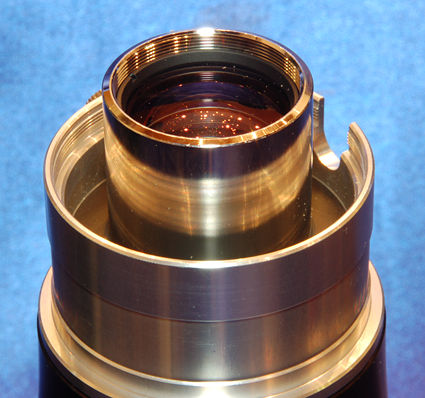
13mm Ethos: The well blackened retainer is in contrast with the shiny filter thread.
Time to look through the eyepieces eventually. First I checked how good internal baffles and blackened edges work. Looking into each eyepiece from a distance and against a bright background offers dark interiors. The developers did a good job on both eyepieces. The inner walls of the Ethos’ look somewhat darker than those of the Explore Scientific. When I turn the Explore Scientific there’s an angle that produces a highlight on a part of the interior. The area around the first lens however is very dark in both eyepieces. Turning them around looking through the negative element reveals highlights in both eyepieces. This view reveals that the Ethos has a somewhat rough or bumpy surface inside and this might be the reason for its darker appearance I mentioned before. I have to mention however that it depends on the internal baffles if the slight disadvantages of the Explore Scientific will lead to visible drawbacks. If internal baffling prevents light from the scope to fall on the inner walls it should be hard or impossible to notice a difference.
Looking for lense edges I come to the conclusion that they are either completely hidden behind baffles or well blackened. But looking alternatingly at both eyepieces reveals that they show very similar reflections which reminded me imidiately on the comparison between the Vixen LVW and the Hyperion and Stratus eypieces. So I took some pictures of the reflections with a fixed camera position to compare them. The pictures show that the lens setup of both eyepieces is indeed quite similar. And looking closely at them reveals that the differences in size result rather from different housings than different optical elements.The longer Explore scientific has a high metal rim around the eye lens while the Ethos has not. I got suspicious: Could the Explore Scientific be nothing else but a cloned Ethos? Maybe reworked to use different glas types to accommodate chinese suppliers? Maybe tweaked a little here and scaled a little there ? Looks like Televue’s secretiveness only served to hold back interesting information for the buyer but did nothing to prevent the design of a clone.
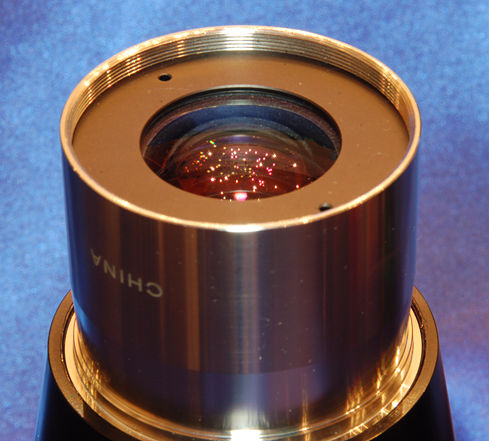
A slightly larger field stop forced the eyepiece to be designed with a 2” barrel.
After that I was really curious how both eyepieces would perform in practice. I challenged them with a nightmare for eyepieces: f/4. Of course a fast Newtonian will show a visible amount of coma in a field of 100 degrees and pinpoint stars to the edge can not be expected. That’s why I used several coma correctors as well. In detail I used my 200/800 Vixen R200SS with the original Vixen coma corrector, a Paracorr PCV-2000 and a special pre-production example of a planned coma corrector. Very secret ;). In addition to the 8” R200SS I also used my 300/1200 Orion UK Newtonian with the same coma correctors.
The results were somewhat disillusioning from the view of an eyepiece-tester. Going over the observations I found that I had a lot to tell about the differences between the three coma correctors while the eyepiece contest ended with a tie. Whatever I looked at – star clusters, star fields, nebulas, galaxies, both eyepieces performed very, very similar. That includes tests like observing the cygnus loop especially around 52 Cygni which is really blinding with a 12 inch aperture and should easily reveal any light scatter or bad coatings.
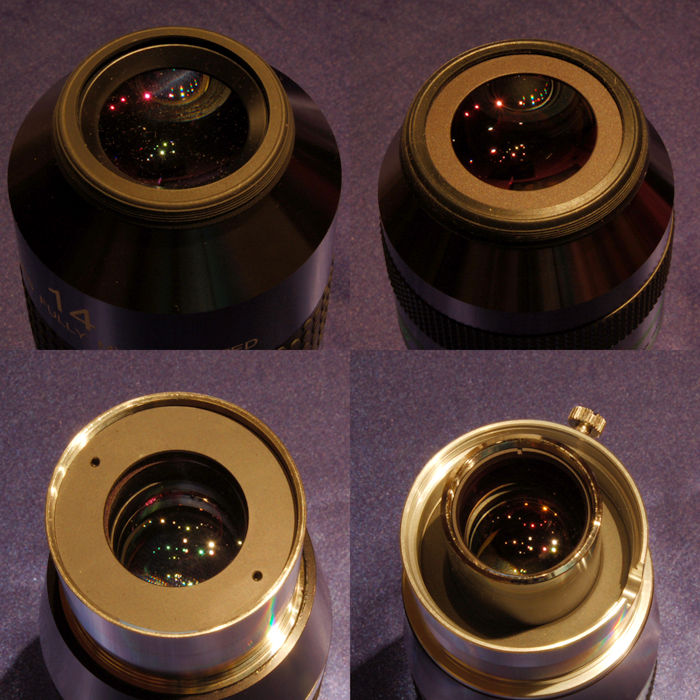
Looking at the reflections reveals that the lens setup of both eyepieces could be very similar.
Without a coma corrector both eyepieces showed – of course – much coma towards the edge. Again to the same extend in both eyepieces. The Vixen corrector brought a great improvement but stars at the edge remained slightly bloated and showed a little bit of coma. Both the Paracorr and the prototype corrector delivered virtually perfect views up to the edge. I got those pinpoint stars that you phantasised about when You read Your first eyepiece advertisement. I got what I expected from some f/8 fluorite apo from an f/4 Newtonian. Great performance! And whenever I suddenly found some distorted stars at the edge I found that I was just obscuring a part of the exit pupil with my iris causing diffraction to deform the stars. Sorry – my fault! Moving my head a little to compensate for the movement of my eye fixed it immediately. Comparing the two correctors I found the Paracorr to add some 16% to the telescope’s focal length while the prototype corrector added only 6%. As a result the darker background with the Paracorr lead to a slight increase of the limiting magnitude at the cost of some true field of view. Concerning true field of view the difference between the two eyepieces was not very apparent even though switching eyepieces was done much faster than switching correctors. Important however was an adjustment of the distance between the coma corrector and the eyepiece which was necessary for an optimum performance at the edge of the field.
The star drift method was the only way to reveal some differences between the eyepieces and – as already mentioned – between the coma correctors. I used Altair and my R200SS. Without the corrector the 14mm Explore Scientific lead to 7 minutes and 4 seconds while the 13mm Ethos needed 6 minutes and 30 seconds for a star to pass through. My old 14mm UWA series 4000 achieved 5 minutes and 42 seconds. The calculated (effective) field-stop diametre matched very well with the official values of both Televue and Explore Scientific. 24.44 millimetres for the 14mm Explore Scientific (24.43 official value) and 22.48 millimetres for the 13mm Ethos (22.3 official value). Without distortion both eyepieces would have quite exactly 82° AFOV which is another hint for a very similar design.
So there are only minor differences to be told. Lunar observation revealed no distracting reflections or an usually bright background. The higher metal rim around the eyelens of the Explore Scientific caused me to push a little harder against the rubber eyecup to achive an ideal position behind the lens. I found the Ethos to be more comfortable concerning this. But in the end I used to fold down the rubber eyecup on both eyepieces as long as there were no disturbing light sources around. However using glasses the Ethos has a slight advantage over the Explore Scientific. I can’t promise that everyone can see the whole one hundred degrees while wearing glasses but there’s a good chance and it’s slightly better with the Ethos. And of course there’s the dioptrix corrector which should make wearing glasses obsolete with the Ethos.
The focal position of both eyepieces was very far out. Especially with the Vixen coma corrector my focuser couldn’t extend far enough and I had to pull the eyepieces out of the adapter with the Ethos usually a little further out.
Observing with my Megrez 110 (110/655 doublet ED) again lead to very similar results. Stars close to the edge showed something like some coma oriented towards the center of the field. Visible in the outer 25% of the field the effect was easily tolerable even close to the edge of the field.
Summing up the review there are no major differences between both eyepieces. We are talking about details which is not what You expect compairing a Televue eyepiece with a Chinese one with similar specifications. Instead we found – maybe for the first time – that the Explore Scientific, be it a clone or not, could deliver virtually the same optical performance. The designers of the Explore Scientific did a good job and the producer took good care of workmanship. As a result the similar performance of both eyepieces makes details of the (mechanical) design more important. And considering this we see Televue’s old fashioned and impractical safety undercut and the incomplicated solution used (but not invented) by Explore Scientific. The smaller rubber grip of the Ethos is suddenly a notable difference. Of course Televue can offer important advantages like the dioptrix, the smaller diametre for binocular use and less weight. For a few observers even the possibility to use 1.25” focusers. But these advantages apply only to some buyers.
So the major difference might be the price with the Explore Scientific sold notably cheaper (in fall 2009).
Addendum
2009-10-24
I don’t know it was just the attraction of the unknown or the consequence of experiences I already made. In the end I found myself in front of a door with an x-ray warning on it and the eyepieces behind that very door. It wasn’t easy to achive good shots. Especially the barrels of both eyepieces proved very opaque to X-ray and the film pieces were a little small for the big eyepieces. The results however solve the mystery and tell the story.
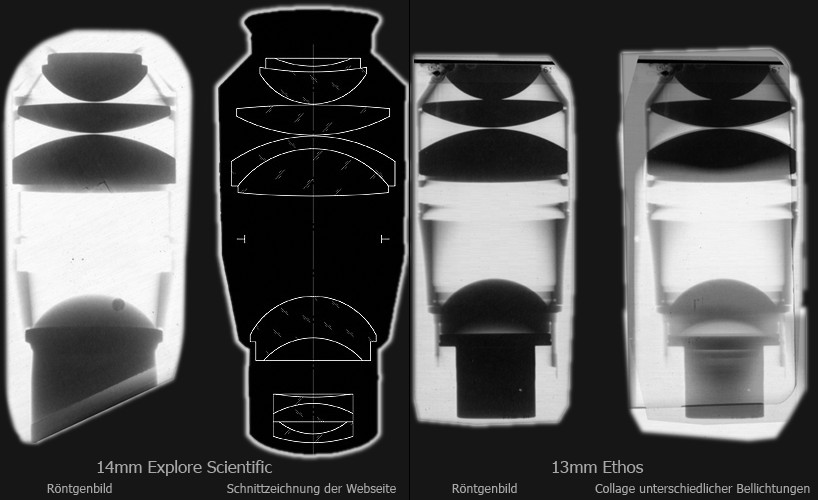
X-ray exposures of the 14mm Explore Scientific (left) and the 13mm Ethos (middle right and right)
compared with the schematic view of the Explore Scientific (middle left).
The picture of the Explore Scientific can be exactly matched with the schematic view on the Explore Scientific website. The two X-ray views of the Ethos show the best single shot and several shots with different exposure times combined. The negative element inside of the barrel remains almost completely invisible. But the rest of the setup was perfectly revealed. Televue could just put 9 lenses in 5 groups into their eyepiece specifications table. They don’t have to protect against somebody cloning their design. Because someone already did.

The X-ray exposure and the schematics of the Explore Scientific match perfectly.
